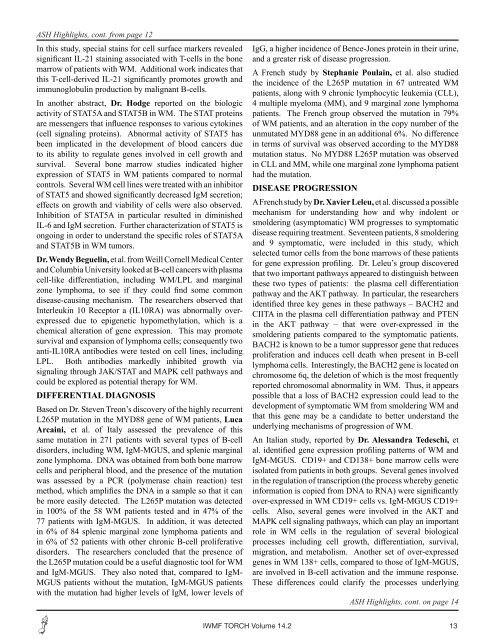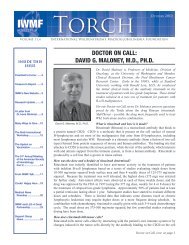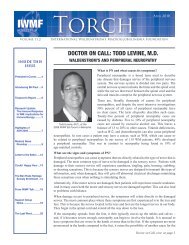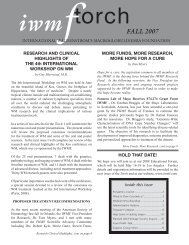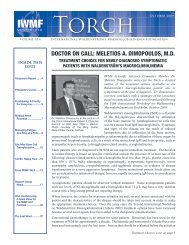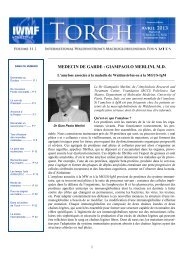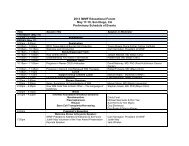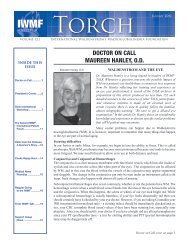English - International Waldenstrom's Macroglobulinemia Foundation
English - International Waldenstrom's Macroglobulinemia Foundation
English - International Waldenstrom's Macroglobulinemia Foundation
Create successful ePaper yourself
Turn your PDF publications into a flip-book with our unique Google optimized e-Paper software.
ASH Highlights, cont. from page 12<br />
In this study, special stains for cell surface markers revealed<br />
significant IL-21 staining associated with T-cells in the bone<br />
marrow of patients with WM. Additional work indicates that<br />
this T-cell-derived IL-21 significantly promotes growth and<br />
immunoglobulin production by malignant B-cells.<br />
In another abstract, Dr. Hodge reported on the biologic<br />
activity of STAT5A and STAT5B in WM. The STAT proteins<br />
are messengers that influence responses to various cytokines<br />
(cell signaling proteins). Abnormal activity of STAT5 has<br />
been implicated in the development of blood cancers due<br />
to its ability to regulate genes involved in cell growth and<br />
survival. Several bone marrow studies indicated higher<br />
expression of STAT5 in WM patients compared to normal<br />
controls. Several WM cell lines were treated with an inhibitor<br />
of STAT5 and showed significantly decreased IgM secretion;<br />
effects on growth and viability of cells were also observed.<br />
Inhibition of STAT5A in particular resulted in diminished<br />
IL-6 and IgM secretion. Further characterization of STAT5 is<br />
ongoing in order to understand the specific roles of STAT5A<br />
and STAT5B in WM tumors.<br />
Dr. Wendy Beguelin, et al. from Weill Cornell Medical Center<br />
and Columbia University looked at B-cell cancers with plasma<br />
cell-like differentiation, including WM/LPL and marginal<br />
zone lymphoma, to see if they could find some common<br />
disease-causing mechanism. The researchers observed that<br />
Interleukin 10 Receptor a (IL10RA) was abnormally overexpressed<br />
due to epigenetic hypomethylation, which is a<br />
chemical alteration of gene expression. This may promote<br />
survival and expansion of lymphoma cells; consequently two<br />
anti-IL10RA antibodies were tested on cell lines, including<br />
LPL. Both antibodies markedly inhibited growth via<br />
signaling through JAK/STAT and MAPK cell pathways and<br />
could be explored as potential therapy for WM.<br />
DIFFERENTIAL DIAGNOSIS<br />
Based on Dr. Steven Treon’s discovery of the highly recurrent<br />
L265P mutation in the MYD88 gene of WM patients, Luca<br />
Arcaini, et al. of Italy assessed the prevalence of this<br />
same mutation in 271 patients with several types of B-cell<br />
disorders, including WM, IgM-MGUS, and splenic marginal<br />
zone lymphoma. DNA was obtained from both bone marrow<br />
cells and peripheral blood, and the presence of the mutation<br />
was assessed by a PCR (polymerase chain reaction) test<br />
method, which amplifies the DNA in a sample so that it can<br />
be more easily detected. The L265P mutation was detected<br />
in 100% of the 58 WM patients tested and in 47% of the<br />
77 patients with IgM-MGUS. In addition, it was detected<br />
in 6% of 84 splenic marginal zone lymphoma patients and<br />
in 6% of 52 patients with other chronic B-cell proliferative<br />
disorders. The researchers concluded that the presence of<br />
the L265P mutation could be a useful diagnostic tool for WM<br />
and IgM-MGUS. They also noted that, compared to IgM-<br />
MGUS patients without the mutation, IgM-MGUS patients<br />
with the mutation had higher levels of IgM, lower levels of<br />
IgG, a higher incidence of Bence-Jones protein in their urine,<br />
and a greater risk of disease progression.<br />
A French study by Stephanie Poulain, et al. also studied<br />
the incidence of the L265P mutation in 67 untreated WM<br />
patients, along with 9 chronic lymphocytic leukemia (CLL),<br />
4 multiple myeloma (MM), and 9 marginal zone lymphoma<br />
patients. The French group observed the mutation in 79%<br />
of WM patients, and an alteration in the copy number of the<br />
unmutated MYD88 gene in an additional 6%. No difference<br />
in terms of survival was observed according to the MYD88<br />
mutation status. No MYD88 L265P mutation was observed<br />
in CLL and MM, while one marginal zone lymphoma patient<br />
had the mutation.<br />
DISEASE PROGRESSION<br />
A French study by Dr. Xavier Leleu, et al. discussed a possible<br />
mechanism for understanding how and why indolent or<br />
smoldering (asymptomatic) WM progresses to symptomatic<br />
disease requiring treatment. Seventeen patients, 8 smoldering<br />
and 9 symptomatic, were included in this study, which<br />
selected tumor cells from the bone marrows of these patients<br />
for gene expression profiling. Dr. Leleu’s group discovered<br />
that two important pathways appeared to distinguish between<br />
these two types of patients: the plasma cell differentiation<br />
pathway and the AKT pathway. In particular, the researchers<br />
identified three key genes in these pathways – BACH2 and<br />
CIITA in the plasma cell differentiation pathway and PTEN<br />
in the AKT pathway – that were over-expressed in the<br />
smoldering patients compared to the symptomatic patients.<br />
BACH2 is known to be a tumor suppressor gene that reduces<br />
proliferation and induces cell death when present in B-cell<br />
lymphoma cells. Interestingly, the BACH2 gene is located on<br />
chromosome 6q, the deletion of which is the most frequently<br />
reported chromosomal abnormality in WM. Thus, it appears<br />
possible that a loss of BACH2 expression could lead to the<br />
development of symptomatic WM from smoldering WM and<br />
that this gene may be a candidate to better understand the<br />
underlying mechanisms of progression of WM.<br />
An Italian study, reported by Dr. Alessandra Tedeschi, et<br />
al. identified gene expression profiling patterns of WM and<br />
IgM-MGUS. CD19+ and CD138+ bone marrow cells were<br />
isolated from patients in both groups. Several genes involved<br />
in the regulation of transcription (the process whereby genetic<br />
information is copied from DNA to RNA) were significantly<br />
over-expressed in WM CD19+ cells vs. IgM-MGUS CD19+<br />
cells. Also, several genes were involved in the AKT and<br />
MAPK cell signaling pathways, which can play an important<br />
role in WM cells in the regulation of several biological<br />
processes including cell growth, differentiation, survival,<br />
migration, and metabolism. Another set of over-expressed<br />
genes in WM 138+ cells, compared to those of IgM-MGUS,<br />
are involved in B-cell activation and the immune response.<br />
These differences could clarify the processes underlying<br />
ASH Highlights, cont. on page 14<br />
IWMF TORCH Volume 14.2<br />
13


